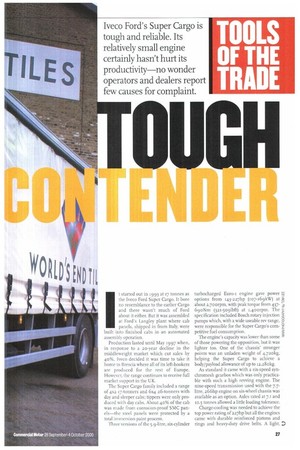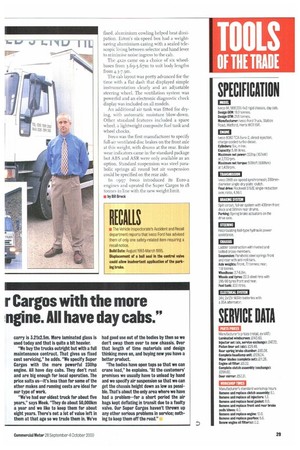OU
Page 29

Page 31

If you've noticed an error in this article please click here to report it so we can fix it.
Iveco Ford's Super Cargo is tough and reliable. Its relatively small engine certainly hasn't hurt its productivity—no wonder operators and dealers report few causes for complaint.
t started out in 1993 at 17 tonnes as the Iveco Ford Super Cargo. It bore no resemblance to the earlier Cargo and there wasn't much of Ford about it either. But it was assembled at Ford's Langley plant where cab panels, shipped in from Italy, were built into finished cabs in an automated assembly operation.
Production lasted until May 1997 when, in response to a 2o-year decline in the middleweight market which cut sales by 40%, Iveco decided it was time to take it home to Brescia where all of its left-hookers are produced for the rest of Europe. However, the range continues to receive full market support in the UK.
The Super Cargo family included a range of 4x2 17-tonners and 6x4 26-tonners with day and sleeper cabs; tippers were only produced with day cabs. About 40% of the cab was made from corrosion-proof SMC panels—the steel panels were protected by a total immersion paint process.
Three versions of the 5.9-litre, six-cylinder turbocharged Euro-1 engine gave power options from 143-227hp (107-169kW) at about 2,7o orpm, with peak torque from 43769oNtn (321-5,991bft) at 1,4 oorprn. The specification included Bosch rotary injection pumps which, with a wide useable rev range, were responsible for the Super Cargo's competitive fuel consumption.
The engine's capacity was lower than some of those powering the opposition, but it was lighter too. One of the chassis' stronger points was an unladen weight of 4,72okg, helping the Super Cargo to achieve a body/payload allowance of up to 12,280kg.
As standard it came with a six-speed synchromesh gearbox which was only practicable with such a high revving engine. The nine-speed transmission used with the 7.7litre, 266hp engine on six-wheel chassis was available as an option. Axles rated at 7.1 and 10.5 tonnes allowed a little loading tolerance.
Charge-cooling was needed to achieve the top power rating of 227hp but all the engines came with durable reinforced pistons and rings and heavy-duty drive belts. A light, fixed, aluminium cowling helped heat dissipation. Eaton's six-speed box had a weightsaving aluminium casing with a sealed telescopic lining between selector and hand lever to minimise noise ingress to the cab.
The 4x25 came on a choice of six wheelbases from 3.69-5.67m to suit body lengths from 4.3-7.3111.
The cab layout was pretty advanced for the time with a flat dash that displayed simple instrumentation clearly and an adjustable steering wheel. The ventilation system was powerful and an electronic diagnostic check display was included on all models.
An additional air tank was fitted for drying, with automatic moisture blow-down. Other standard features included a spare wheel, a lightweight composite fuel tank and wheel chocks.
Iveco was the first manufacturer to specify full-air ventilated disc brakes on the front axle at this weight, with drums at the rear. Brake wear indicators came in the standard package but ABS and ASR were only available as an option. Standard suspension was steel parabolic springs all round but air suspension could be specified on the rear axle.
In 1997 Iveco introduced its Euro-a engines and uprated the Super Cargos to 18 tonnes in line with the new weight limit.
in by Bill Brock












































































































